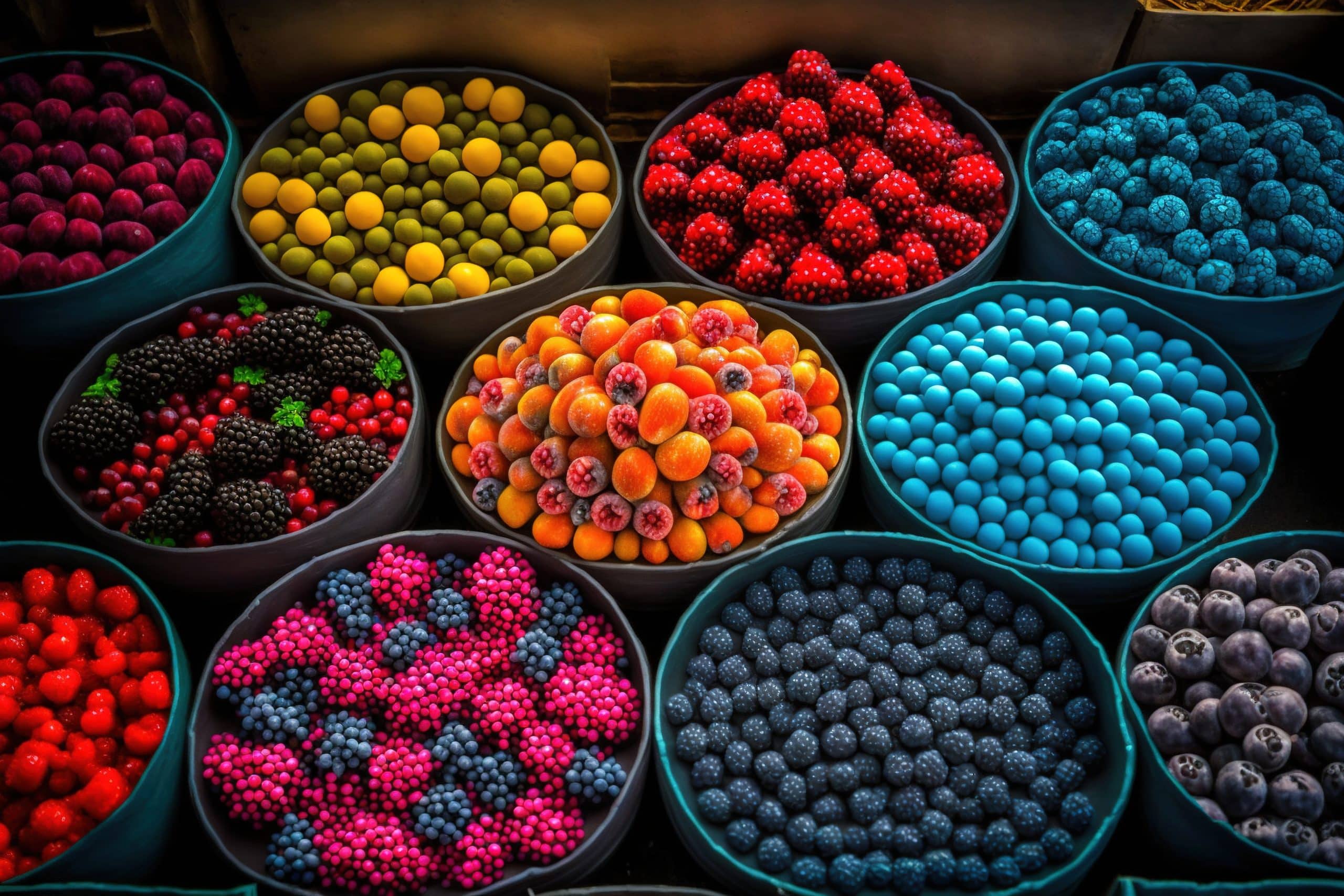You’ve probably heard someone refer to a fruit as nature’s candy, and there’s a good reason for it. Although it’s sweet, its sugar has little in common with the table sugar we’re all too familiar with; and, it comes with plenty of healthy fiber, water, and various beneficial compounds. Among these naturally sweet treats, berries hold a special place. They are not only delicious but also filled with antioxidants and vitamins.
Get your personalized
meal plan!
Today, we’re presenting a comprehensive A-Z guide on these fruity little wonders. From Acai to Ziziphus, let’s explore the enchanting world of berries, their unique characteristics, nutritional benefits, and why they deserve a constant presence in our diet.
What Are The Different Types of Berries?
Berries are a diverse group of fruits, and their classification can be quite fascinating. In botanical terms, a berry is a fleshy fruit produced from a single ovary. This broad definition actually includes many fruits that we don’t typically think of as berries, such as bananas, tomatoes, and even grapes.
If you struggle to even flirt with the idea of giving up your favorite foods or working out till your legs give way – BetterMe app is here to breathe a fresh perspective into the way you view the weight loss process! Check out the app and experience the fun side of fitness and dieting with BetterMe!
However, in everyday language, we tend to classify berries based on certain shared characteristics, like small size, juicy texture, and often a vibrant color. These are the fruits we commonly refer to as “berries” – such as strawberries, blueberries, and raspberries.
Berries can further be classified into several categories. Here are some broad classifications:
1. True Berries
These are fruits that come from a flower with one ovary and typically have several seeds. Examples include blueberries, cranberries, and gooseberries.
2. Aggregate Fruits
These fruits develop from multiple ovaries of a single flower. Each tiny fruit in the cluster comes from one ovary, and together they form what we recognize as a single fruit. The strawberry is a prime example of an aggregate fruit.
3. Multiple Fruits
These are fruits that develop from a cluster of flowers, also known as an inflorescence. Each flower in the cluster produces a fruit, but they all merge together to form a single larger fruit. A good example of this is the pineapple.
4. Accessory Fruits
With these fruits, the part we eat comes not just from the ovary, but also from other parts of the flower. The apple is perhaps the most famous accessory fruit.
While these classifications might seem a bit complicated, they help us understand the incredible diversity of berries and other fruits. Despite their differences, all berries share some common traits: they are packed with nutrients, beneficial plant compounds, and offer a variety of flavors and textures that make them a favorite in diets around the world.
Different Types of Berries List from A-Z
There are over 400 types of berries in the world, each with its own unique taste, texture, and health benefits. Here are some of the most common and widely-recognized berries:
- Acai Berries: Native to South America, acai berries are often used in smoothies and bowls for their high antioxidant content.
- Aronia Berries: Also known as chokeberries, aronia berries are native to North America and have a tart, almost bitter flavor. They’re often used in juices, jams, and wines.
- Avocados: Another surprising member of the berry family, avocados are creamy, rich, and packed with healthy fats, folate, and fiber.
- Barberries: Known for their tart flavor, barberries are commonly used in Persian cuisine and have a bright red color.
- Bilberries: These are closely related to types of blueberries and huckleberries and are native to Europe.
- Blackberries: Larger and darker than raspberries, blackberries are juicy and very rich in antioxidants. They are one of the most common types of black berries
- Blueberries: Known for their vibrant color and sweet taste, blueberries are also packed with antioxidants.
- Boysenberries: A cross between a raspberry and blackberry, boysenberries are large, juicy, and perfect for pies and jams.
- Cape Gooseberries: These small, golden berries are wrapped in a papery husk and have a sweet-tart flavor.
- Cherries: While often thought of as a separate type of fruit, cherries are classified as a type of berry known as a drupe. They come in sweet and tart varieties.
- Chili Peppers: All types of chili peppers, from sweet bell peppers to spicy jalapenos, are technically berries.
- Cloudberries: These are rare, orange-colored berries that grow in colder climates and have a slightly tart taste.
- Cranberries: Often consumed as juice or dried fruit, cranberries have a distinctive tart taste and are especially popular during the holiday season.
- Currants: Small and tart, currants can be red, white, or black and are often used in baking and jam-making.
- Dates: These sweet, sticky fruits are actually a type of berry.
- Eggplants: Believe it or not, eggplants are classified as berries! They’re used as a vegetable in cooking, but botanically, they’re a berry.
- Elderberries: Typically made into syrups, jams, or wines, elderberries are known for their antioxidant properties (2).
- Figs: Sweet and slightly chewy, figs are technically a type of berry known as a syconium.
- Goji Berries: Also known as wolfberries, goji berries are native to Asia and are often consumed dried or in teas due to their potential health benefits.
- Golden Berries: Also known as ground cherries, golden berries are wrapped in a papery husk and have a sweet-tart flavor.
- Gooseberries: These can range in color from green to red to black, and they have a unique, tart flavor.
- Goumi Berries: These small, bright red berries are native to East Asia and are known for their tart, slightly astringent flavor.
- Guavas: These tropical fruits are technically berries. They have a sweet, slightly acidic flavor and are rich in vitamin C.
- Huckleberries: Similar to blueberries but with a more intense flavor, huckleberries are a favorite for making desserts, syrups, and preserves.
- Indian Gooseberries: Also known as amla, Indian gooseberries are a key ingredient in Ayurvedic medicine and have a sour, bitter taste.
- Juniper Berries: While technically a cone and not a berry, juniper berries are often used as a spice, particularly in European cuisine and in flavoring gin.
- Kiwifruit: Despite their name, kiwifruits are actually berries. They have a unique tart-sweet flavor and vibrant green color.
Read more: Benefits of Kiwi, Nutrition Facts, Side Effects, and More.
- Kumquats: While they look like miniature oranges, kumquats are actually classified as berries. They have a sweet rind and tart flesh.
- Loganberries: A cross between a blackberry and raspberry, loganberries are slightly tart and are often used in making jams and wines.
- Lychees: These tropical fruits have a delicate, sweet flavor and are considered berries.
- Maqui Berries: Native to South America, maqui berries are rich in antioxidants and have a sweet, slightly tart flavor.
- Marionberries: A type of blackberry developed in Oregon, marionberries are known for their complex, rich flavor.
- Mulberries: These sweet berries come in a variety of colors, including white, red, and black.
- Muscadine Grapes: These are a type of grape native to the southern United States, and like all grapes, they’re technically considered berries.
- Passion fruit: Known for their vibrant flavor, passion fruits are considered berries. They have a sweet-tart taste and are filled with numerous small seeds.
- Peppercorns: The dried fruit of the black pepper plant, peppercorns are also considered a type of berry.
- Persimmons: Also considered a berry, persimmons are bright orange fruits that have a sweet, honey-like flavor when fully ripe.
- Pomegranates: Each pomegranate is filled with hundreds of tiny, juicy seeds known as arils, each of which is technically a berry.
- Rambutan: A tropical fruit native to Southeast Asia, rambutan is technically a berry. Its unique appearance features soft, hair-like spikes.
- Raspberries: These berries come in several colors including red types of berries, black, and golden. They have a sweet yet slightly tart flavor.
- Red Raspberries: These bright red berries are sweet and tart, and are often used in jams, jellies, syrups, and desserts.
- Salmonberries: Native to the Pacific Northwest, salmonberries are orange-pink in color and have a mild, sweet flavor.
- Saskatoon Berries: Also known as serviceberries or juneberries, Saskatoon berries resemble blueberries in appearance but have a unique almond-like flavor.
- Sea Buckthorn Berries: These tart berries are rich in vitamin C and are often used in health supplements and skin care products (17).
- Strawberries: These are perhaps one of the most popular berries. They are sweet, tangy, and perfect for a variety of dishes from salads to desserts.
- Surinam Cherries: Despite their name, these are not true cherries but are indeed berries. They have a unique bell shape and a tart flavor.
- Tayberries: Named after the river Tay in Scotland, tayberries are a cross between a blackberry and a raspberry and are known for their unique sweet-tart flavor.
- Tomatillos: These are small, green fruits enclosed in a papery husk. They’re used in Mexican cuisine and are technically a type of berry.
- Yew Berries: These are small, bright red berries produced by yew trees. However, while the flesh is sweet and edible, the seeds are highly toxic.
- Zante Currants: Despite their name, Zante currants are actually tiny, dried grapes. They’re sweet and tangy, often used in baking.
- Zezt: Zezt are a type of berry native to Australia. They are small, black, and have a flavor similar to that of traditional blackberries.
- Zucchini: Surprisingly, zucchinis are technically a type of berry known as a “pepo”. They’re used as a vegetable in cooking, but botanically, they’re a berry.
- Zwetschge Plums: A type of European plum, Zwetschge plums are a type of drupe, which is a category of pitted fruits that includes some types of berries. They’re often used in baking, particularly in German and Eastern European cuisines.
- Ziziphus Berries: Also known as jujube or Chinese date, Ziziphus berries are native to Asia. They are small and round with a sweet flavor. In traditional medicine, they are often used for their purported calming and immune-supporting properties (3). They can be eaten fresh, dried, or used in cooking and baking.
What Are the Top 3 Healthiest Berries?
All berries are healthy and offer various nutritional benefits. The ranking can vary based on specific nutritional criteria. That said, some of the most popular and healthiest berries include:
Blueberries
Blueberries are loaded with antioxidants, specifically anthocyanins, which may protect against heart disease, certain cancers, cognitive decline, and diabetes. They also have high amounts of fiber and vitamin C (12).
Raspberries
Raspberries are high in dietary fiber, vitamin C, manganese, and antioxidants. They contain polyphenols that may help reduce the risk of metabolic diseases like cardiovascular disease, diabetes, obesity, and Alzheimer’s (13).
Strawberries
Strawberries are an excellent source of vitamin C, manganese, folate (vitamin B9), and potassium. They are rich in antioxidants and plant compounds, which may have benefits for the prevention of chronic diseases (10).
Remember, all berries are healthy and offer various nutritional benefits. The ranking can vary based on specific nutritional criteria.
Whether you’re a workout beast or just a beginner making your first foray into the world of fitness and dieting – BetterMe has a lot to offer to both newbies and experts! Install the app and experience the versatility first-hand!
What Are the Top 10 Berries?
The “top” berries can vary depending on the criteria used to rank them, such as popularity, nutritional value, or taste. However, based on general recognition and consumption, the top 10 berries might include:
- Strawberries: Known for their sweet taste and versatility in various dishes.
- Blueberries: Appreciated for their sweet flavor and high antioxidant content.
- Raspberries: Loved for their sweet-tart flavor and often used in desserts.
- Blackberries: Larger and darker than raspberries, they’re enjoyed fresh or in jams.
- Cranberries: While quite tart, they’re a staple in many sauces and juices.
- Goji Berries: These have gained popularity for their potential health benefits and are often consumed dried (8).
- Acai Berries: Often used in smoothies and bowls, acai berries are known for their high antioxidant content (1).
- Bilberries: Similar to blueberries and known for their high antioxidant content.
- Elderberries: Used in syrups and wines, they’re recognized for their antioxidant properties (2).
- Cherries: Cherries, particularly sweet cherries, are loved for their taste and are eaten fresh or used in cooking and baking.
Which Berries Are Best for the Brain?
Certainly, here’s that information in a more prose-like format:
When it comes to promoting brain health, certain berries stand out for their exceptional benefits. Blueberries, often referred to as a superfood, are at the top of the list. The flavonoids present in blueberries may help protect the brain against neurodegenerative diseases, and scientific studies have linked them to slower rates of cognitive decline in older adults (12).
Strawberries also play a significant role in health. They are rich in phytochemicals that are important for overall health, and they have also been linked with slower rates of cognitive decline along with blueberries (16). Similarly, blackberries, abundant in anthocyanins antioxidants, are thought to protect brain health (9).
The exotic acai berry, renowned for its high antioxidant content, is believed to help protect the brain from oxidative stress (1). Lastly, cranberries, packed with beneficial antioxidants, may contribute to overall brain health (6).
Is It OK To Eat Berries Every Day?
Yes, it is generally safe and beneficial to eat berries every day. They are rich in antioxidants, vitamins, and fiber, which contribute to overall health (14).
However, like any food, they should be consumed as part of a balanced diet and in moderation to avoid potential digestive discomfort from their high fiber content. It’s always best to consult with a healthcare professional if you have specific dietary concerns or health conditions.
Frequently Asked Questions
Which Berry Has the Most Antioxidants?
The berry with the most antioxidants is typically regarded to be the Acai Berry. However, it’s important to note that all berries, including blueberries, blackberries, and raspberries, are high in antioxidants and contribute to overall health.
Do blueberries lift your mood?
While there’s no definitive scientific evidence linking blueberries directly to mood enhancement, they do contain nutrients like flavonoids, which have been associated with reduced symptoms of depression (7).
So, while they may not directly ‘lift your mood,’ their nutritional profile can contribute to overall brain health and well-being. Plus, eating something you enjoy can have a positive effect on your mood.
How Many Carbs Are in Various Types of Berries?
Here are the carb contents for 100 grams of some common berries:
- Blueberries: 14.6 grams (5)
- Strawberries: 7.96 grams (15)
- Raspberries: 12.9 grams (11)
- Blackberries: 9.6 grams (4)
These values can vary slightly depending on the ripeness and specific variety of the berry.
Read more: Eggplant for Weight Loss: How it Works and Some Recipes to Consider.
The Bottom Line
From the antioxidant-rich Acai to the zesty Zereshk, our A-Z guide on types of berries introduces you to a world of fruity little wonders. Discover the nutritional profiles, health benefits, and unique flavors of each berry type as we take you on a delicious journey through nature’s candy store.
DISCLAIMER:
This article is intended for general informational purposes only and does not serve to address individual circumstances. It is not a substitute for professional advice or help and should not be relied on for making any kind of decision-making. Any action taken as a direct or indirect result of the information in this article is entirely at your own risk and is your sole responsibility.
BetterMe, its content staff, and its medical advisors accept no responsibility for inaccuracies, errors, misstatements, inconsistencies, or omissions and specifically disclaim any liability, loss or risk, personal, professional or otherwise, which may be incurred as a consequence, directly or indirectly, of the use and/or application of any content.
You should always seek the advice of your physician or other qualified health provider with any questions you may have regarding a medical condition or your specific situation. Never disregard professional medical advice or delay seeking it because of BetterMe content. If you suspect or think you may have a medical emergency, call your doctor.
SOURCES:
- Açaí (Euterpe oleracea Mart.) in Health and Disease: A Critical Review (2023, mdpi.com)
- Advanced research on the antioxidant and health benefit of elderberry (Sambucus nigra) in food – a review (2015, sciencedirect.com)
- A Review of Dietary Ziziphus jujuba Fruit (Jujube): Developing Health Food Supplements for Brain Protection (2017, hindawi.com)
- Blackberries, raw (2022, fdc.nal.usda.gov)
- Blueberries, raw (2022, fdc.nal.usda.gov)
- Chronic Consumption of Cranberries (Vaccinium macrocarpon) for 12 Weeks Improves Episodic Memory and Regional Brain Perfusion in Healthy Older Adults: A Randomised, Placebo-Controlled, Parallel-Groups Feasibility Study (2022, frontiersin.org)
- Exploring the Impact of Flavonoids on Symptoms of Depression: A Systematic Review and Meta-Analysis (2021, mdpi.com)
- Goji Berries as a Potential Natural Antioxidant Medicine: An Insight into Their Molecular Mechanisms of Action (2019, hindawi.com)
- Neuroprotective effects of berry fruits on neurodegenerative diseases (2014, ncbi.nlm.nih.gov)
- Promising Health Benefits of the Strawberry: A Focus on Clinical Studies (2016, pubmed.ncbi.nlm.nih.gov)
- Raspberries, raw (2022, fdc.nal.usda.gov)
- Recent Research on the Health Benefits of Blueberries and Their Anthocyanins (2020, sciencedirect.com)
- Red Raspberries and Their Bioactive Polyphenols: Cardiometabolic and Neuronal Health Links (2016, sciencedirect.com)
- Review of Functional and Pharmacological Activities of Berries (2021, mdpi.com)
- Strawberries, raw (2022, fdc.nal.usda.gov)
- Strawberry as a functional food: an evidence-based review (2014, pubmed.ncbi.nlm.nih.gov)
- Wide Spectrum of Active Compounds in Sea Buckthorn (Hippophae rhamnoides) for Disease Prevention and Food Production (2021, mdpi.com)










